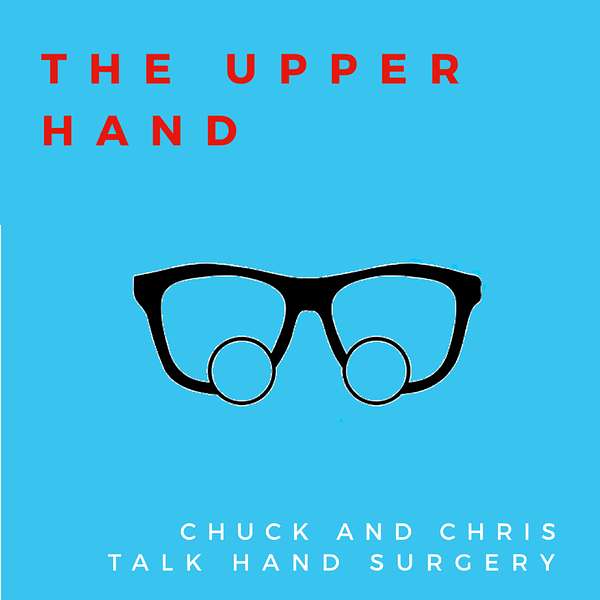
The Upper Hand: Chuck & Chris Talk Hand Surgery
The Upper Hand: Chuck & Chris Talk Hand Surgery
Handling Referrals Plus Tips and Tricks for Common Surgeries
Chuck and Chris discuss a listener submitted query around handling referrals. We also discuss our tips and tricks around common surgeries including carpal tunnel release, trigger ringer release, and ganglion excxision. Join us to hear our opinions and always feel free to share yours at handpocast@gmail.com
We are in need of a podcast intern! We would appreciate any referrals!
See www.practicelink.com/theupperhand for more information from our partner on job search and career opportunities.
The Upper Hand Podcast is sponsored by Checkpoint Surgical, a provider of innovative solutions for peripheral serve surgery. To learn more, visit https://checkpointsurgical.com/.
As always, thanks to @iampetermartin for the amazing introduction and concluding music.
For additional links, the catalog. Please see https://www.ortho.wustl.edu/content/Podcast-Listings/8280/The-Upper-Hand-Podcast.aspx
Summary
Research Updates and Grant Applications
Charles and Christopher discussed a recent research meeting and upcoming board plans. Christopher shared his experience at the Nerve Summit in Cleveland, where he met with 20-25 peripheral nerve surgeons from across North America. They discussed grant applications, with Christopher mentioning he submitted grants to the RAF in June and NIH last week, and is awaiting decisions on previous submissions. The conversation concluded with a mention of their sponsor, PracticeLink.
Optimal Referral Practices in Surgery
Christopher and Charles discussed the handling of referrals in medical practice. They explored how to approach referrals both to and from other surgeons, emphasizing the importance of confidence, honesty, and maintaining good relationships with referring physicians. They highlighted the value of phone calls over emails for complex referrals and stressed the need to balance being honest without undermining the referring physician. Christopher shared his experience of referring challenging cases to senior partners and the importance of building trust with patients when suggesting a second opinion.
Carpal Tunnel Surgery Techniques
Christopher and Charles discussed tips and tricks for common hand surgeries, focusing on the mini open carpal tunnel release. Charles emphasized the importance of consistency in surgical techniques and predicted that this procedure might be replaced by robotics in the future. They shared their approaches to the surgery, including the use of specific retractors and instruments, and agreed on the value of having a standardized, predictable method.
Carpal Tunnel Surgery Techniques
Charles and Christopher discussed their techniques for carpal tunnel release surgery. They agreed on using the sharp end of a scalpel to flatten the carpal tunnel and keep the palm flat during the procedure. Christopher emphasized the importance of using a new 15-blade for the TCL transaction and avoiding spreading within the carpal tunnel to prevent patient discomfort. They also discussed using smaller Navy scalpels for difficult cases and releasing the palmar fascia to allow better access to the TCL.
Carpal Tunnel and Trigger Finger Surgery Techniques
Christopher and Charles discussed surgical techniques for carpal tunnel and trigger finger procedures. They shared their approaches to incision marking, patient communication, and post-operative care. Christopher described his use of dissolvable sutures and telemedicine follow-ups, while Charles outlined his preferred method of using three sutures and a small dressing. They also discussed incision techniques for trigger finger surgery, with Charles advocating for a longitudinal incision and Christopher explaining his method of centering the incision based on the A1 pulley's location.
Trigger Finger Surgery Techniques
Charles and Christopher discussed techniques for releasing pulleys during trigger finger surgery. Charles explained his approach of releasing the A1 pulley completely, along with portions of the A2 and PA pulleys, while Christopher described his practice of releasing the entire PA pulley and 10-20% of the A2. They shared their methods for assessing patients, both awake and under anesthesia, and discussed techniques for removing a slip of the flexor digitorum superficialis (FDS) when necessary. Christopher also described his post-operative dressing protocol, which includes using web roll tweeners and Coban for compression, and explained that he provides patients with extra dressing material and exam gloves to use at home.
Dorsal Wrist Ganglion Surgery Discussion
Charles and Christopher discussed their approaches to performing dorsal wrist ganglion surgery. They shared similar techniques, including using a transverse incision, careful dissection, and protecting the SL ligament. Charles emphasized the importance of taking the surgery step-by-step and removing a segmented capsule to reduce recurrence. Christopher noted that he has become more deliberate in his decisions during the procedure. They also discussed post-operative protocols, with Charles using a splint and Christopher opting for a bulky dressing followed by a cock-up wrist brace. Both surgeons expressed openness to learning new techniques from listeners and encouraged feedback via email.